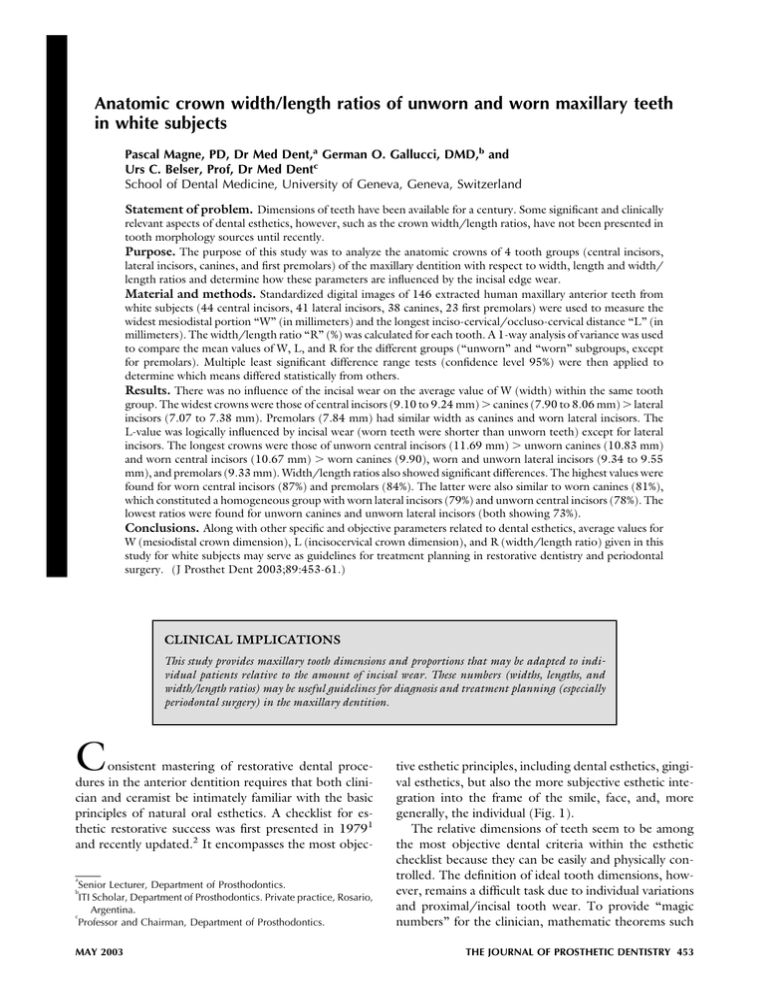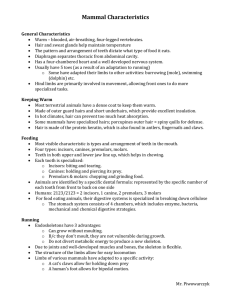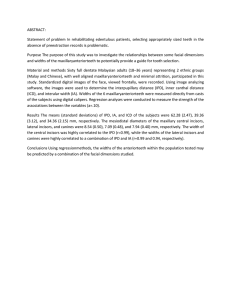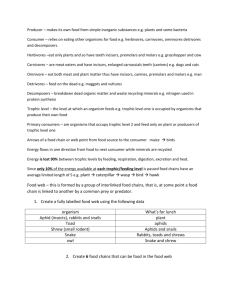Anatomic crown width/length ratios of unworn and worn maxillary
advertisement

Anatomic crown width/length ratios of unworn and worn maxillary teeth in white subjects Pascal Magne, PD, Dr Med Dent,a German O. Gallucci, DMD,b and Urs C. Belser, Prof, Dr Med Dentc School of Dental Medicine, University of Geneva, Geneva, Switzerland Statement of problem. Dimensions of teeth have been available for a century. Some significant and clinically relevant aspects of dental esthetics, however, such as the crown width/length ratios, have not been presented in tooth morphology sources until recently. Purpose. The purpose of this study was to analyze the anatomic crowns of 4 tooth groups (central incisors, lateral incisors, canines, and first premolars) of the maxillary dentition with respect to width, length and width/ length ratios and determine how these parameters are influenced by the incisal edge wear. Material and methods. Standardized digital images of 146 extracted human maxillary anterior teeth from white subjects (44 central incisors, 41 lateral incisors, 38 canines, 23 first premolars) were used to measure the widest mesiodistal portion “W” (in millimeters) and the longest inciso-cervical/occluso-cervical distance “L” (in millimeters). The width/length ratio “R” (%) was calculated for each tooth. A 1-way analysis of variance was used to compare the mean values of W, L, and R for the different groups (“unworn” and “worn” subgroups, except for premolars). Multiple least significant difference range tests (confidence level 95%) were then applied to determine which means differed statistically from others. Results. There was no influence of the incisal wear on the average value of W (width) within the same tooth group. The widest crowns were those of central incisors (9.10 to 9.24 mm) ⬎ canines (7.90 to 8.06 mm) ⬎ lateral incisors (7.07 to 7.38 mm). Premolars (7.84 mm) had similar width as canines and worn lateral incisors. The L-value was logically influenced by incisal wear (worn teeth were shorter than unworn teeth) except for lateral incisors. The longest crowns were those of unworn central incisors (11.69 mm) ⬎ unworn canines (10.83 mm) and worn central incisors (10.67 mm) ⬎ worn canines (9.90), worn and unworn lateral incisors (9.34 to 9.55 mm), and premolars (9.33 mm). Width/length ratios also showed significant differences. The highest values were found for worn central incisors (87%) and premolars (84%). The latter were also similar to worn canines (81%), which constituted a homogeneous group with worn lateral incisors (79%) and unworn central incisors (78%). The lowest ratios were found for unworn canines and unworn lateral incisors (both showing 73%). Conclusions. Along with other specific and objective parameters related to dental esthetics, average values for W (mesiodistal crown dimension), L (incisocervical crown dimension), and R (width/length ratio) given in this study for white subjects may serve as guidelines for treatment planning in restorative dentistry and periodontal surgery. (J Prosthet Dent 2003;89:453-61.) CLINICAL IMPLICATIONS This study provides maxillary tooth dimensions and proportions that may be adapted to individual patients relative to the amount of incisal wear. These numbers (widths, lengths, and width/length ratios) may be useful guidelines for diagnosis and treatment planning (especially periodontal surgery) in the maxillary dentition. C onsistent mastering of restorative dental procedures in the anterior dentition requires that both clinician and ceramist be intimately familiar with the basic principles of natural oral esthetics. A checklist for esthetic restorative success was first presented in 19791 and recently updated.2 It encompasses the most objeca Senior Lecturer, Department of Prosthodontics. ITI Scholar, Department of Prosthodontics. Private practice, Rosario, Argentina. c Professor and Chairman, Department of Prosthodontics. b MAY 2003 tive esthetic principles, including dental esthetics, gingival esthetics, but also the more subjective esthetic integration into the frame of the smile, face, and, more generally, the individual (Fig. 1). The relative dimensions of teeth seem to be among the most objective dental criteria within the esthetic checklist because they can be easily and physically controlled. The definition of ideal tooth dimensions, however, remains a difficult task due to individual variations and proximal/incisal tooth wear. To provide “magic numbers” for the clinician, mathematic theorems such THE JOURNAL OF PROSTHETIC DENTISTRY 453 THE JOURNAL OF PROSTHETIC DENTISTRY MAGNE, GALLUCCI, AND BELSER Fig. 1. New esthetic checklist. Reprinted with permission from Magne P, Belser U. Bonded porcelain restorations in the anterior dentition: A biometric approach. Quintessence Publ. Co. Inc, Chicago 2002. as the “golden proportion”3,4 and the “golden percentage”5 have been proposed, taking into account classic elements of art and architecture. These rules were applied to the apparent size, as viewed directly from the anterior. Lombardi,3 the first to mention golden numbers for anterior teeth, stated that strict application of the golden proportion has proved to be too rigid for dentistry. Measurements by Preston6 confirmed the unrealistic nature of the golden rule in this specific context. Excessive narrowness of the maxillary arch and compression of lateral segments can be observed in situations of strict adherence to the golden rule as illustrated in Figure 2. In addition, it appears that tooth height, crown width/length ratios, transition line angles, and other special effects of tooth form are likely to influence the perception of symmetry, dominance, and proportion. Among the aforementioned parameters, measurements of width/length ratios of normal clinical crowns seem to represent the most stable reference; a homogeneous ratio (⬃81%) was found by Sterrett et al7 for the 3 anterior maxillary tooth groups. Such measurements were carried out on clinical crowns of normal subjects with stone casts derived from irreversible hydrocolloid impressions and excluded teeth with incisal wear and premolars. Data regarding natural tooth dimensions are accessible through a number of tooth morphology sources (textbooks and journal articles).8-11 In spite of the fact that mesiocervical and incisocervical dimensions of teeth 454 have been made available since 1902,8 it is only recently that the crown width/length ratios have been considered.7 The purpose of this work was to investigate some uncharted aspects of tooth dimensions and analyze the anatomical crown of the 4 maxillary tooth groups (central incisors, lateral incisors, canines, and first premolars) with respect to width, length, and width-length ratios and provide data that distinguishes unworn from worn teeth. MATERIAL AND METHODS One hundred forty-six extracted human maxillary anterior teeth from white subjects (44 central incisors, 41 lateral incisors, 38 canines and 23 first premolars) were used for this study. All teeth were free of restorations and decay and the cementoenamel junction (CEJ) was clearly visible. After undergoing scaling and ultrasonic cleaning, teeth were grouped according to their type and divided into “worn” and “unworn” subgroups. The criteria for this selection were the presence of a marked incisal wear facet along with well-defined dentin exposure (Fig. 3). Premolars were all considered unworn (all specimens displayed unworn buccal cusps). Standardized photographs of the buccal surface were made by use of a digital camera (Fujifilm Finepix S1 Pro; Fuji Photo Film, Tokyo, Japan) attached to a photographic stand (RT 1; Kaiser, Buchen, Germany). Teeth were posiVOLUME 89 NUMBER 5 MAGNE, GALLUCCI, AND BELSER THE JOURNAL OF PROSTHETIC DENTISTRY Fig. 3. View of central incisors using tangential light to show incisal edge configuration: unworn incisor (left) with thin rounded incisal edge and worn incisor (right) with marked incisal wear facet along with well-defined dentin exposure. Fig. 2. Measurements made according to apparent width of teeth, viewed directly from anterior. A, Original view of central incisors, lateral incisor and left canine do not conform to golden proportion. B, Same image digitally modified to generate golden numbers: lateral incisor now in proportion of 1:1.618 with central incisor and 1:0.618 with canine; size of central incisor was maintained. Corresponding configuration would result in abnormally narrow maxillary arch (endognathic or micrognatic arch). Reprinted with permission from Magne P, Belser U. Bonded porcelain restorations in the anterior dentition: A biometric approach. Quintessence Publ. Co. Inc, Chicago 2002. Fig. 4. Measurement technique. Longest apicocoronal distance (parallel to long axis, between most apical point of CEJ and most incisal point of anatomical crown) and widest mesiodistal portion (perpendicular to long axis) measured for each specimen. tioned visually according to their main axis and recorded at original magnification ⫻ 1.5, resulting in 146 digital photographs (resolution maintained at 1536 by 2304 pixels and 8-bit grayscale, generating 3.5-megabyte files). An image-processing program (Scion Image; developed at the Research Services Branch of the National Institute of Mental Health, Bethesda, Md.) was used to measure (1) the widest mesiodistal portion “W” (perpendicular to the long axis) and (2) the longest apicocoronal distance “L” (parallel to the long axis, between the most apical point of the CEJ and the most incisal point of the anatomic crown) (Fig. 4). A special calibration tool built in Scion image was used to convert all distances into millimeters. The data were then transferred to a spreadsheet program for mathematical treatment, including the calculation of the width/length ratio “R”. Statistical analysis was carried out to compare the 3 tooth groups. A 1-way analysis of variance was used to compare the mean values of W, L, and R for the 7 different subgroups. Multiple least significant difference range tests (confidence level 95%) were then applied to determine which means differed statistically from others. MAY 2003 455 THE JOURNAL OF PROSTHETIC DENTISTRY MAGNE, GALLUCCI, AND BELSER Table I. The mean (mm) (in bold), followed by standard deviation (in parentheses) and range of the width, length and W/L ratio of the 4 tooth types of the maxillary dentition Table II. Result of statistical analysis for WIDTH (P ⬍ .05, homogeneous groups determined by multiple range tests, confidence level 95%) RESULTS The mean, standard deviation and range of the width, length, and width/length ratio are presented in Table 1. In each situation, analysis of variance outcomes required multiple range tests to identify homogeneous groups (Tables 2 through 4). Within the same tooth group, there was no influence of the incisal wear on the average crown width. The 456 widest crowns were those of central incisors (9.10 to 9.24 mm), followed by canines (7.90 to 8.06 mm) and lateral incisors (7.07 to 7.38 mm). Premolars (7.84 mm) had similar width as canines and worn laterals. Crown length was logically influenced by incisal wear, with worn teeth showing significantly lower values compared with unworn teeth except for lateral incisors. Three homogeneous groups were found: the longest crowns were that of unworn central incisors (11.69 mm) VOLUME 89 NUMBER 5 MAGNE, GALLUCCI, AND BELSER THE JOURNAL OF PROSTHETIC DENTISTRY Table III. Result of statistical analysis for LENGTH (P ⬍ .05, homogeneous groups determined by multiple range tests, confidence level 95%) Table IV. Result of statistical analysis for W/L RATIO (P ⬍ .05, homogeneous groups determined by multiple range tests, confidence level 95%) followed by unworn canines (10.83 mm) and worn central incisors (10.67 mm). The shortest crowns were those of worn canines (9.90 mm), worn and unworn lateral incisors (9.34 to 9.55 mm), and premolars (9.33 mm). Width/length ratios also showed significant differences: highest values were found for worn central incisors (87%) and premolars (84%). The latter were also similar to worn canines (81%), which constituted a homogeneous group with worn lateral incisors (79%) and unworn central incisors (78%). The lowest ratios were found for unworn canines and unworn lateral incisors (both showing 73%). DISCUSSION Even though it would appear more relevant to measure clinical crowns, this experimental protocol intended to use extracted teeth and anatomic crown measurement instead. The reasons for this choice are explained below. MAY 2003 Width measurements of extracted teeth can be extremely precise because of the proximal clearance (absence of neighboring teeth); the precision of clinical measurements (including those made on casts) can be jeopardized, especially with overlapping teeth. This specific reason could explain why average widths in this study are approximately 1 mm larger compared with clinical measurements (from casts derived from irreversible hydrocolloid impressions) reported by Sterrett et al.7 Length measurements were confined apically by the CEJ, which normally sets the position and structure of the soft tissues.12,13 However, the relationship between CEJ and gingival level can show variations within and above normal range,12 sometimes exposing part of the root, sometimes covering enamel, an example of which would be altered passive eruption. In this context, it seems appropriate to use the CEJ (and not the gingival level) as a reference for the establishment of “natural” guidelines. Accordingly, average lengths in this study are 457 THE JOURNAL OF PROSTHETIC DENTISTRY MAGNE, GALLUCCI, AND BELSER Fig. 6. Average incisal edge wear computed from data of Table 3 (unworn/worn differences in length for incisors and canines). Fig. 5. Teeth of equal width (dotted rectangles in A and B) but different length and incisal edge configuration appear to have different widths. approximately 1 mm longer compared with clinical measurements by Sterrett et al.7 From these data, the following ranking for crown width can be established for the population studied (Table 2): centrals⬎canines/premolars⬎laterals. Within the same tooth group, these measurements were logically not influenced by the degree of incisal wear. It must be pointed out, however, that the perceived width of a tooth may be highly influenced by shape (length), and especially interincisal angles (Fig. 5). Even though it is rare to observe golden numbers in anterior teeth, as explained in the introduction,6 lateral incisors and canines feature opened interincisal angles that naturally generate the perception of narrowness: these teeth appear narrower than they really are, therefore providing the illusion of the golden proportion, which is dominated by the central incisors. In other words, the mea458 sured width of a tooth should always be considered along with tooth shape. The following ranking for crown length of the specimens in this study was established for the population studied (Table 3): unworn centrals⬎unworn canines/ worn centrals⬎ laterals/premolars/worn canines. For centrals and canines, these measurements were influenced by the degree of incisal wear (not for laterals). The difference between unworn and worn teeth was calculated for centrals/laterals/canines and is illustrated in Figure 6. Average wear for centrals and canines (1.02 and 0.93 mm, respectively) was twice that of laterals (0.41 mm). These results may be explained by the occlusal scheme (canine guidance in lateral excursions and central incisor guidance in protrusion); lateral incisors, being on average 1 to 1.5 mm shorter than centrals and canines, can be significantly protected from incisal wear. The ranking for width/length ratio for the specimens studied (Table 4) emphasizes the difference between unworn teeth, with average ratios between 73% to 78%, and worn teeth with average ratios between 79% to 87%. The shape of low-ratio type of crowns was dominated by length (Fig. 5, A), whereas that of high-ratio type of crowns tended to fit in a rather square shape (Fig. 5, B). When considered within the frame of a smile, increased width/length ratios would appear to have an aging effect. Figure 7 depicts the situation of a 40-year old woman with accelerated enamel loss, resulting in rather high ratios, which was treated with bonded porcelain restorations (veneers). The new smile design was rejuvenated and features significantly decreased ratios. Both results regarding the width and length of the teeth in this study were dominated by the central incisors. Dominance appeared to be the most important parameter of facial esthetics. As stated by Lombardi,3 “Just as unity is the prime requisite of a good composition, dominance is the prime requisite to provide unity.” The mouth constitutes the dominant feature of the face by virtue of its size. By the same token the central incisor VOLUME 89 NUMBER 5 MAGNE, GALLUCCI, AND BELSER THE JOURNAL OF PROSTHETIC DENTISTRY Fig. 7. A-C, Patient featuring reduced crown width/length ratios caused by erosion and wear. D-F, New situation (increased ratios) after placement of bonded porcelain restorations. is the dominant tooth of the smile; thus, dominance must be considered in harmony with personality. It seems appropriate, when treatment planning in the anterior dentition, to start by the definition of adequate incisal edge length. Clinicians can identify altered width, length, or width/length ratios. As illustrated in Figure 7, significant changes in these values have rejuvenated a smile. Such modifications can be achieved without specific MAY 2003 measurements or mathematical rules by use of natural senses. There are more complex situations, however, where the knowledge and application of some numeric guidelines may be of significant help. Figure 8 illustrates a typical situation where bonded porcelain restorations were indicated. Reduced tooth size and diastemata affected the patient’s smile. At the level of central incisors, closing of the interdental spaces would result in ⬎100% width/length ratios. Smile analysis revealed that the in459 THE JOURNAL OF PROSTHETIC DENTISTRY MAGNE, GALLUCCI, AND BELSER Fig. 8. A, Diagnostic steps before treatment of reduced size teeth and diastemata. B, Directional coincidence of incisal edges (also called “smile line”, dotted curve) and lower lip (white curve) provides cohesive forces to dentofacial composition; incisal edges of central incisors have been positioned accordingly. C, Closing of space between central incisors generates width/length ratio of 99%, which calls for gingival correction (black dotted line). D, Use of dimensions of central incisors as reference, procedure can be extended to other teeth. cisal edge could be elongated to fit the lower lipline. The resulting elongation, however, still generates a high ratio (⬃99%). Adequate tooth proportions were restored only after modifying the contour of the gingiva. The amount of periodontal correction was estimated on the basis of an average ratio. This study provided the basis to modify tooth width and length for this individual’s situation as a function of related amount of incisal wear (from 78% for unworn central incisors, up to 87% for worn teeth). These guidelines were applied to lateral incisors and canines and can now be established to plan periodontal surgery and further diagnostic steps. It must be pointed out again that the values given by this study can only serve as guidelines, providing that the other specific and objective parameters of dental esthetics have been considered (Fig. 1). CONCLUSIONS This work investigated the anatomic crown of the 4 anterior maxillary tooth groups of white subjects (cen460 tral incisors, lateral incisors, canines, and first premolars) with respect to width (W), length (L), and width-length ratios, with special attention to distinguish between unworn and worn teeth for a selected group of tooth specimens. Within the limitations of this study, the following conclusions were made: 1. There was no influence of incisal wear on the average value of W within the same tooth group. The widest crowns were those of central incisors (9.10 to 9.24 mm) ⬎ canines (7.90 to 8.06 mm) ⬎ lateral incisors (7.07 to 7.38 mm). Premolars (7.84 mm) had similar width as canines and worn lateral incisors. 2. The L-value was logically influenced by incisal wear (worn teeth were shorter than unworn teeth) except for lateral incisors. The longest crowns were those of unworn central incisors (11.69 mm) ⬎ unworn canines (10.83 mm) and worn central incisors (10.67 mm) ⬎ worn canines (9.90 mm), worn and unworn lateral incisors (9.34 to 9.55 mm), and premolars (9.33 mm). VOLUME 89 NUMBER 5 MAGNE, GALLUCCI, AND BELSER THE JOURNAL OF PROSTHETIC DENTISTRY 3. Width/length ratios also showed significant differences: highest values were found for worn central incisors (87%) and premolars (84%). The latter were also similar to worn canines (81%), which constituted a homogeneous group with worn lateral incisors (79%) and unworn central incisors (78%). The lowest ratios were found for unworn canines and unworn lateral incisors (both showing 73%). We express our gratitude to Dr Minos Stavridakis (research fellow, University of Geneva) for providing the extracted teeth and to Dr Maria Cattani (Division of Dental Materials, University of Geneva) for computing of the statistical analyses presented in this study. REFERENCES 1. Belser UC. Esthetics checklist for the fixed prosthesis. Part II: Biscuit-bake try-in. In: Schärer P, Rinn LA, Kopp FR, editors. Esthetic guidelines for restorative dentistry. Chicago: Quintessence; 1982. p. 188-92. 2. Magne P, Belser U. Natural oral esthetics. In: Magne P, Belser U, editors. Bonded porcelain restorations in the anterior dentition: a biomimetic approach. Chicago: Quintessence; 2002. p. 57-96. 3. Lombardi RE. The principles of visual perception and their clinical application to denture esthetics. J Prosthet Dent 1973;29:358-82. 4. Levin EI. Dental esthetics and the golden proportion. J Prosthet Dent 1978;40:244-52. 5. Snow SR. Esthetic smile analysis of maxillary anterior tooth width: the golden percentage. J Esthet Dent 1999;11:177-84. 6. Preston JD. The golden proportion revisited. J Esthet Dent 1993;5:247-51. 7. Sterrett JD, Oliver T, Robinson F, Fortson W, Knaak B, Russell CM. Width/length ratios of normal clinical crowns of the maxillary anterior dentition in man. J Clin Periodontol 1999;26:153-7. 8. Black GV. Descriptive anatomy of the human teeth. Philadelphia: The S.S. White Dental Manufacturing; 1902. 9. Ash MM. Wheeler’s dental anatomy, physiology and occlusion. 7th ed. Philadelphia: WB Saunders; 1992. 10. Shillingburg HT Jr, Kaplan MJ, Grace SC. Tooth dimensions—a comparative study. J South Calif Dent Assoc 1972;40:830-9. 11. Bjorndal AM, Henderson WG, Skidmore AE, Kellner FH. Anatomic measurements of human teeth extracted from males between the ages of 17 and 21 years. Oral Surg Oral Med Oral Pathol 1974;38:791-803. 12. Gargiulo A, Wentz F, Orban B. Dimensions and relations of the dentogingival junction in humans. J Periodontol 1961;32:261-7. 13. Ash M. Physiologic form of the teeth and the periodontium. In: Ash M, editor. Wheeler’s dental anatomy, physiology and occlusion. 7th ed. Philadelphia: WB Saunders; 1992. p. 102-27. Reprint requests to: DR PASCAL MAGNE UNIVERSITY OF GENEVA SCHOOL OF DENTAL MEDICINE DEPARTMENT OF PROSTHODONTICS 19, RUE BARTHÉLEMY-MENN CH-1205 GENÈVE SWITZERLAND FAX: 41-22-372-94-97 E-MAIL: pascal.magne@medecine.unige.ch Copyright © 2003 by The Editorial Council of The Journal of Prosthetic Dentistry. 0022-3913/2003/$30.00 ⫹ 0 doi:10.1016/S0022-3913(03)00125-2 Availability of JOURNAL Back Issues As a service to our subscribers, copies of back issues of The Journal of Prosthetic Dentistry for the preceding 5 years are maintained and are available for purchase from the publisher, Mosby, until inventory is depleted. Please write to Mosby, Subscription Customer Service, 6277 Sea Harbor Dr, Orlando, FL 32887, or call 800-654-2452 or 407-345-4000 for information on availability of particular issues and prices. MAY 2003 461




